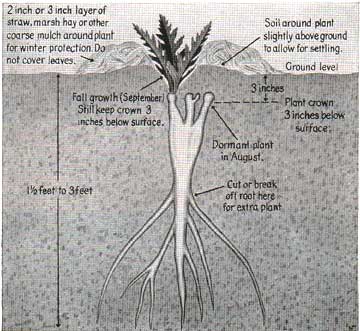Oriental poppies are one of our hardiest and most colorful perennials. Many clumps 20 years old are still giving brilliance to gardens each spring. Unfortunately, though, many gardeners consider them hard to grow because losses have resulted from spring planting or planting pot-grown plants with poor root systems. Lack of good drainage (which is absolutely necessary) accounts for the rest of the failures.
The only satisfactory time to plant or transplant Oriental poppies is during the dormant season in late July and August, or during the fall growth in September and October. I personally prefer dormant planting, but most dealers don’t send out plants until they have started growth as they receive too many complaints from customers receiving “dead” plants. If the plants are dormant they should not be overwatered; just enough to settle the soil is sufficient as too much will cause rot.

Oriental poppies should be planted upright with the crowns 3 inches below the surface. This is very important as the 3 inches of soil protects the plant from heaving, helps support the heavy bloom and keeps out crown rot which is the only disease I know of that attacks Oriental poppies.
As soon as the plants have finished blooming cut off all bloom stems close to the ground leaving a 1- or 2-inch stub on the plant. This prevents a crop of orange red seedlings but, even more important, these short stubs will usually stay on the plant and protect the crown until fall growth pushes them off. An inch or two of soil or sand over the crown is good added protection during the dormant season.
If a well-established poppy plant fails to appear in the fall, or even next spring, do not disturb the spot for in a majority of cases it will be back as strong as ever after a year’s absence. When the root gets large it often becomes hollow and is attacked with crown rot. When this decay reaches solid root it usually stops and new buds are formed in the ends of the roots. These take lime to reach the surface.
When dividing or propagating poppies from root cuttings use heavy pieces of root 6 to 8 inches long. Plant upright, making sure you have the upper end of the root up, 3 inches below the surface and you should have one or two blooms the following spring. A light mulch of straw, marsh hay or other material is necessary the first winter to prevent heaving.
by A Curtis – 62846
